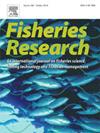Red snapper in the Gulf of Mexico: Can offshore populations export larval subsidies to nearshore fishing grounds?
IF 2.2
2区 农林科学
Q2 FISHERIES
引用次数: 0
Abstract
The contribution of red snapper offshore populations to the replenishment of exploited areas in the Gulf of Mexico has been a source of debate and uncertainty in the management of this species for decades. Here, we investigate the spatial patterns of larval connectivity of red snapper in the Gulf, estimating source-sink dynamics and exploring how exploitation pressure can alter these patterns. Our results suggest that while the offshore cryptic biomass can contribute a large percentage of settlers to the Gulf, offshore biomass is unlikely to replenish highly exploited nearshore fishing grounds due to low likelihood of larval transport between offshore and nearshore habitats. Our results also indicate that high fishing pressure in nearshore areas, particularly by the recreational fishery, can change larval connectivity patterns. Taken together, our study provides insight into the complex interactions between heterogeneous fishing pressure and larval source-sink dynamics. Overall, this study highlights the importance of managing for localized depletion and balancing commercial and recreational fishing priorities. The findings emphasize the need for fine-scale spatial considerations in red snapper fishery management to address larval connectivity dynamics and mitigate the impact of exploitation.
求助全文
约1分钟内获得全文
求助全文
来源期刊

Fisheries Research
农林科学-渔业
CiteScore
4.50
自引率
16.70%
发文量
294
审稿时长
15 weeks
期刊介绍:
This journal provides an international forum for the publication of papers in the areas of fisheries science, fishing technology, fisheries management and relevant socio-economics. The scope covers fisheries in salt, brackish and freshwater systems, and all aspects of associated ecology, environmental aspects of fisheries, and economics. Both theoretical and practical papers are acceptable, including laboratory and field experimental studies relevant to fisheries. Papers on the conservation of exploitable living resources are welcome. Review and Viewpoint articles are also published. As the specified areas inevitably impinge on and interrelate with each other, the approach of the journal is multidisciplinary, and authors are encouraged to emphasise the relevance of their own work to that of other disciplines. The journal is intended for fisheries scientists, biological oceanographers, gear technologists, economists, managers, administrators, policy makers and legislators.
 求助内容:
求助内容: 应助结果提醒方式:
应助结果提醒方式:


